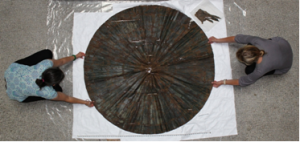As a conservation intern, it is always exciting to walk into the lab and to see my colleagues at their benches working on objects. Objects are fascinating to me because they tell us about the development of technological skills which in turn has shaped our material culture.
A recently excavated pavement from the Republic of Bénin dated between the 9th and 13th century arrived in the lab along with six vessels requiring some reconstruction and support for display purposes. The client requested the pavement fragments to be laid into a matrix that would imitate the context in which it was discovered.
Figure 1: completed pavement destined for the Crossroads of Empires exhibition at SCVA
Working from both the photograph and the plan, the tiles were assembled, consolidated, backed with a rigid support and set in a pigmented background (working alongside the Design & Technical team).
A large ceramic vessel from the same archaeological site has also been reconstructed and gap filled. The vessel is incomplete but enough of it has survived for a successful reconstruction. Both the lifted pavement and the ceramic vessel will be going on display at the Crossroads of Empires: Archaeology in West Africa exhibition at The Sainsbury for Visual Arts this coming month, 20 October—1 February 2015.
Figure 2: vessel being reconstructed
A fancy floral 1900’s hat made an appearance for treatment and mounting. Several other textiles have been prepared, condition reported and packed for a loan to the Design Museum in London for their forth coming Women Fashion Power exhibition. Two WW1 costumes have been prepared for King’s Lynn and Thetford’s temporary WW1 exhibitions. A 19th century Norwich silk wedding dress is currently being conserved and mounted before being displayed at the Bridewell.
Moving on from our income generating work we are currently home to a very dirty hardened snap dragon skin, rescued from the interior of another snap in the collection. It desperately requires cleaning, humidifying and reshaping to make the object more accessible. We also have been working on a large funeral parasol that was discovered during the Shine a Light project. This will be conserved and made more accessible in the Costume and Textile store.
Figure 3: pre-treatment assessment of the funeral parasol
The Norwich Civic silver has been decanted. Some pieces require cleaning whilst the case is to receive a deep clean. A moose head from the Natural History department has been cleaned, and has safely made its way to Manchester University Museum for an exhibition. Some seagull feet have been repaired and a bearded tit had its tail reattached to its body! Last but not least, two of our conservators lifted an iron shield boss from an Anglo-Saxon grave, with remnants of organic material present.
Figure 4: excavating the shield boss
This variety of activity is one reason why I love the conservation profession. Seeing archaeological and historical material in the same lab is exciting, and the challenges of devising a bespoke conservation treatment for each object is always stimulating.
Martha Infray, ICON Conservation Intern
Follow us on Twitter @ConserveNMS




